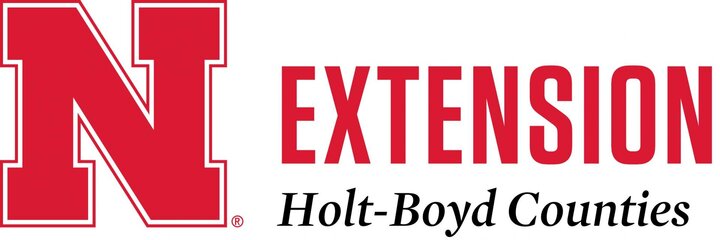
Nebraska Extension Educator - Holt/Boyd Counties - LaDonna Werth
Nebraska Extension Educator - Holt/Boyd Counties - Amy Timmerman
Nebraska Extension Educator - Brown/Rock/Keya Paha Counties - Brittany Spieker
Nebraska Extension Educator - Holt/Boyd/Garfield/Loup/Wheeler Counties - Bethany Johnston
Nebraska 4-H Assistant - Holt/Boyd Counties - Debra Walnofer
July 7: Holt County 4-H Shooting Sports - .22 Rifle, SB Pistol, Muzzleloader, SG, BB Gun, AR, AP, Practice + Coach’s Meeting; Holt County Fairgrounds, Chambers, NE
July 10: DUE: Boyd County Fair Entries Close, https://boyd.fairwire.com
July 10: DUE: Boyd County Fair Animal Entries, Static Entries (INCLUDES Shooting Sports)
July 10: DUE: Boyd County YQCA Certificates; Horse Levels Completed and Pen/Stall/Cage Request
July 11: Young Rancher Workshop - Nebraska Grazing Lands Coalition and Ranch Management Consultants - Burwell, Nebraska, Contact Leah Peterson: director@nebraskagrazinglands.org, 308-872-1250
July 15: Holt County Pre-Fair Day, 9:00am, Solid Rock Youth Center, O’Neill, NE
July 16: Boyd County Pre-Fair Day, 3:00pm, St. Mary’s Catholic Church Hall, Spencer, NE
July 17: DUE: Boyd County Bucket Calf, Bottle Lamb, and Bottle Goat Record Books
July 17: Boyd County Fair Set-Up, 7:00pm, Boyd County Fairgrounds, Spencer
July 19-20: Boyd County Fair 4-H Shooting Sports Competitions, 2:30pm, Gross, NE
July 22: Entry Day for Boyd County Fair Static Entries
July 22-26: Boyd County Fair, Boyd County Fairgrounds, Spencer, NE
August 2-9: Holt County Fair, Holt County Fairgrounds, Chambers, NE
Getting My Baby or Toddler Ready for School? Are You Nuts?!?!
If you are the parent or early childhood educator of a baby or toddler, you may cringe at the thought of sending your little child off to school. How can you help now when it seems so far away? Have no fear! There are many things that you can do now to prepare children for school.
In fact, one of the easiest is to communicate often with little ones and help them with their communication skills. Communicating well with others is an important part of succeeding in school. Children need to listen to their teachers and understand what they are saying. They also need to get along with other children and use words to express their thoughts, needs, and feelings.
Lucky for you, most children are born ready to communicate. To hold up your side of the conversation, you need to understand how babies and toddlers communicate, actively encourage them to communicate, and look for patterns in the way they communicate.
Babies tell us about their thoughts, needs, and feelings with coos, gurgles, and grunts, facial expressions, cries, body movements like cuddling or back arching, eye movements such as looking towards and looking away, and arm and leg movements.
To encourage babies' communication, quickly respond to their efforts and use a "sing-song" tone of voice, exaggerated face, and wide-open eyes. Babies love looking at faces and when you make your face interesting to look at, babies will pay attention. Babies
LaDonna Werth
Extension Educator
Phone: 402-336-2760
E-mail: lwerth2@unl.edu

also like hearing songs and feeling your gentle touch or tickle. Be sure to make the most of the times when you are close and facing a baby, such as during diapering and feeding.
Pay attention to each baby's unique style of emotion expression, activity level, and social nature. Some babies are quiet and watchful and prefer less adult interaction. Other babies are emotional, active, and seek continuous adult attention. Some babies are in between. Be sensitive to each baby's personality and work with your baby's preferences; this makes communication smoother for everyone!
Give meaning to babies' communication efforts. Because babies are not yet talking, we need to do some guessing at first to understand what they are telling us. If you gently tickle a baby's chin and the baby responds by frowning and turning away, give the baby's effort meaning and say, "Oh, you're frowning. I don't think you like it when I tickle your chin; I'll stop." If you softly sing and show the baby an exaggerated face, and baby responds by smiling and reaching for you, say, "Look at that smile! I think you like this song, I'll sing it again and then try a new one."
Babies need to know that their efforts to communicate are heard and understood. Take time to learn how babies tell you about their thoughts, needs, and feelings. When babies experience your warmth and attention, they form a sense of trust in the world.
As babies grow into toddlers, they communicate in new and different ways. Toddler communication begins with a combination of gestures and grunts and then moves to one word sentences and, later, two word sentences. Toddlers also use their positive and negative emotions and body movements to tell us what they are thinking and feeling.
To encourage toddlers' communication, take time to build sentences around toddlers' efforts. If a toddler points at the refrigerator and grunts, say, "Are you telling me that you are thirsty? I'll get you a bottle." If during snack a toddler says, "More," you can say, "Are you hungry for some more apple? I'll slice another one." When you respond and build sentences like this, toddlers know that they are being heard and understood. It also provides an opportunity for you to introduce new words into the child's vocabulary. Keep a word diary of toddlers' growing vocabulary and share it with others so that familiar words can be used and new ones introduced.
Because toddlers are starting to understand the order of things, use daily routines as an opportunity to talk about the sequence of events. When getting toddlers dressed, play a game of "What comes first? Pants or diaper? Socks or shoes?" Also, because toddlers are trying to do things by themselves, create opportunities to help them establish independence. For instance, during play, let toddlers control the action and decide what is going to happen. You can act like a sportscaster and describe exactly what toddlers are doing and how. "Gabriel is driving the car quickly across the couch…now he's making a sharp turn around the pillow. Oh no, the car has crashed into the back of the couch! What is going to happen next…?"
As with babies, toddlers need to know that their grunts, gestures, words, and actions are heard and understood. Use your interactions with toddlers to build their vocabulary and become skilled communicators. Being able to effectively communicate allows toddlers to understand what is asked of them. Also, it helps toddlers to better express their own thoughts, needs, and feelings.
Few things in life come with so small a price tag and so great a reward as communicating with the babies and toddlers in our lives. Children rely on adults to help them learn about themselves and to make sense of the world. Helping babies and toddlers to develop effective communication skills is an important tool for school, and for life.
Source: Sara Gable, Ph.D., Human Development and Family Studies, College of Human Environmental Sciences, University of Missouri-Columbia
Soybean White Mold Management Season is Here
As we approach the critical period for managing white mold in soybeans, it's essential to make timely and informed decisions to mitigate potential losses. Sclerotinia stem rot, or white mold, significantly impacted yields in 2021 and 2023 soybean crops, and proactive management is crucial for this season. The key factors to keep in mind as you monitor and manage fields are:
- Flowering Susceptibility: Soybean plants are most vulnerable to white mold infection during the flowering stage (R1 to R3).
- Protective Measures: Ensuring flowers are protected is essential for preventing infection and controlling the disease. Late management will not save infected plants.
- Environmental Conditions: Wet, humid environments facilitate the spread of white mold.
- Field History: Fields with a prior history of white mold are at greater risk of occurrence, often beginning in the same hotspots where infection occurred in past seasons due to the persistence of sclerotia in the soil.
For detailed management strategies, including genetic resistance, cultural practices and chemical/biological control, please refer to the sections below.
Amy Timmerman
Extension Educator
Phone: 402-336-2760
E-mail: atimmerman2@unl.edu

Pathogen Overview
Sclerotinia stem rot, commonly known as white mold, is a fungal disease caused by Sclerotinia sclerotiorum. The fungus survives between seasons in the soil as hard, black, dark structures called sclerotia. In spring, saturated soils and a full canopy favor the emergence of apothecia, mushroom-like structures that release millions of airborne spores during flowering. These spores infect soybeans primarily through senescing blossoms and injured tissue, requiring free moisture for infection. The disease typically prevents successful pod development and produces more sclerotia on and in the stems, which are scattered back onto the soil during harvest and can survive for several years.
Disease Symptoms
Symptoms of white mold usually appear during pod development and can be subtle at first. The disease often begins with wilting and discoloration of leaves, followed by stem and pod infections that show white, cottony fungal growth and black sclerotia. Water-soaked lesions typically form near colonized flowers, and stems become tan, brittle and hollow, sometimes containing sclerotia. Affected stems frequently shred when pulled apart and show signs/symptoms approximately 6 to 14 inches above the soil surface, although lower stems may also be infected as well.
Favorable Environmental Conditions
White mold develops from flowering to pod formation under wet, humid conditions with moderate temperatures (<85°F). It is more prevalent in northern Nebraska counties and irrigated fields throughout central Nebraska, due to the consistent moisture and cooler canopy temperatures.
Management Strategies
Genetic Resistance: Choose varieties rated well against white mold, avoiding highly susceptible ones, and select shorter varieties that do not lodge.
Cultural Practices: In fields with a history of significant white mold, use wider row spacing (30-inch over 15-inch) to delay canopy closure and reduce humidity. Avoid irrigation during flowering if possible. Rotate with non-host crops like corn and maintain good weed control, as some weeds and cover crops can host the fungus. Tillage has been considered for control, but it is not recommended due to water consideration and the lack of effective control.
Manganese management is another consideration. Be aware that improper soil manganese levels will prevent plants from effective white mold defense. Soil manganese adjustments should be made before the season. Foliar manganese feeding can also be done in season, but it should be done before flowering begins.
Chemical/Biological Control: Apply foliar fungicides during the susceptibility window at flowering if there is a field history of white mold and favorable weather conditions for disease development. Late applications made after the infection window are not effective. Refer to the Crop Protection Network and the UNL 2025 Guide for Weed, Disease, and Insect Management in Nebraska for fungicide efficacy test results to find products that are effective on the pathogen.
Resources
Crop Protection Network: https://cropprotectionnetwork.s3.amazonaws.com/soybean-foliar-efficacy-2025.pdf
Guide for Weed, Disease and Insect Management in Nebraska: https://marketplace.unl.edu/extension/ec130.html
Source: Dylan Mangel - Extension Plant Pathologist, Roshani Baral - Plant Pathologist (CropWatch – June 27, 2025)
How Much Supplemental Manganese Does My Cowherd Require?
Manganese (Mn) is an essential trace mineral that is especially critical in the development of the calf. Diets deficient in Mn fed to pregnant cows have been shown to cause dwarfism and joint deformities. Preventing Mn deficiency starts with assessment of Mn in available feedstuffs; grass pasture is often sufficient in Mn, corn silage often has relatively low Mn and all silages can have high iron (Fe) content that decreases Mn availability from the diet.
Manganese and the Cowherd
The cow’s requirements for Mn is 40 ppm in the diet (DM basis).
Observations from industry and research trials highlight that heifers and cows fed Mn-deficient diets during pregnancy, especially those incorporating silage, can lead to skeletal deformities and joint enlargement and/or joint laxity in newborn calves. Joint laxity can cause calves to “knuckle” over, making it hard for them to stand.
In most grazing scenarios, Mn requirements are met entirely through forages, but producers can supplement part of the requirement as a precautionary measure. Supplementing 25% of the Mn requirement, or 10 ppm to the total diet, is recommended (1300 ppm in 4 oz intake free choice mineral).
Bethany Johnston
Extension Educator
Phone: 402-336-2760
E-mail: bjohnston3@unl.edu

Silage and Mn Absorption
Silage-based diets are a concern regarding Mn absorption. During harvest and storage, silages can be contaminated with dirt, and thus, introducing additional Fe into the feedstuff. Unlike hay or grazing situations, the acidic environment during ensiling makes Fe in the dirt available for absorption, decreasing the Mn available from the diet. Thus, more Mn may be needed in these scenarios to overcome high Fe content. Soil contamination can be high when earthen bunkers or dirt pads are used, increasing the risk of high Fe interfering with Mn absorption.
Testing silages for not only Mn, but also Fe, is the first line of defense for Mn nutrition. Data collected from Nebraska feedstuffs highlighted the need for additional Mn in silage-based diets. Of submitted corn silage samples, nearly 1/3 had greater than 200 ppm Fe, representing some antagonism of Mn absorption. These samples also had less than the cow requirement for Mn, analyzing at 35 ppm Mn, on average. In scenarios where Fe exceeds 200 ppm, it is recommended that 60-75% of the Mn requirement is supplemented (3000-4000 ppm in 4 oz intake free choice mineral).
Additionally, small grains chopped for silage are prone to limited Mn absorption due to high Fe. While samples of small grain silages had an average Mn concentration of 86 ppm, the average Fe concentration was 725 ppm. Seventy-five percent of submitted samples contained more than 200 ppm Fe and nearly 40% had more than 500 ppm Fe. This large increase in Fe may be due to the need to windrow and wilting the forage before chopping creating contact with soil and soil contamination during chopping. To overcome high antagonistic pressure at or above 500 ppm Fe, it is suggested to supply close to the Mn requirement (4000 ppm in 4 oz intake free choice mineral).
Conclusion
Mn is crucial for growth, reproduction, and several metabolic processes in cattle. While pastures generally provide sufficient Mn, diets relying on silage may require supplementation, especially if dirt contamination is an issue. Meeting the Mn requirement supports fetal calf development, but exceeding the requirement does not benefit performance. Overall, Mn supplementation should account for Mn content in feedstuffs and interference from Fe in silage-based diets.
Source: Brock Ortner - Nebraska Extension Livestock System Educator, Mary Drewnoski - Nebraska Extension Beef Systems Specialist (BeefWatch – July 1, 2025)
Picnic Smarts: Tips for a Safe & Tasty Summer
July is National Picnic Month. This is a perfect time of year to grab a blanket, pack a basket, and enjoy a meal outdoors with family and friends. But before you head outside, let’s talk about something that can quickly ruin a good picnic: foodborne illness, commonly known as food poisoning. It can happen when food isn’t cooked properly, kept at the right temperature, or handled in an unsafe way. And in hot summer weather, those risks go up quickly.
Here are a few simple tips to keep your outdoor meals safe and enjoyable:
- Keep hot foods hot and cold foods cold.
Perishable foods - whether hot or cold - need to be kept at safe temperatures. Cold foods should stay at or below 40°F in a cooler with plenty of ice or ice packs. Hot foods, like grilled meats, should be held at 140°F or above in insulated containers until serving time. - Limit how long food sits out.
Once food is served, it shouldn’t be left out at room temperature for more than 2 hours - or just 1 hour if it’s above 90°F outside. This applies to all perishable foods, hot or cold. After that, bacteria can multiply quickly, so it’s safest to pack leftovers back into a cooler or throw them away.
Brittany Spieker
Extension Educator
Phone: 402-387-2213
E-mail: bspieker2@unl.edu

- Wash up before you dig in.
Hand washing is always ideal before prepping food or eating. But if there’s no access to running water, bring hand sanitizer or moist towelettes. Clean hands are your best defense against foodborne illness. Also, be sure to keep cutting boards, utensils, and prep areas clean - especially when handling raw meat. - Avoid cross-contamination.
Use separate plates and utensils for raw and cooked foods. Don’t put grilled burgers or grilled chicken back on the same plate that held the raw meat. Be sure to switch out or wash tongs and serving tools before using them with cooked food.
Also consider packing raw meat in its own cooler, separate from ready-to-eat foods, to help prevent cross-contamination before you even start cooking - When in doubt, throw it out.
If food has been sitting out too long, smells off, or looks questionable, don’t take a chance. It’s better to throw it out than risk getting sick.
With just a few simple steps, you can enjoy your summer picnics with peace of mind. Food safety is part of a healthy lifestyle - and it helps keep your celebrations fun and worry-free.
News Release
Contact: Mitch Stephenson, mstephenson@unl.edu | 308-632-1355
Research Update & Prescribed Burn Tour at UNL Barta Brothers Ranch- July 16
The University of Nebraska–Lincoln’s Barta Brothers Ranch Field Day will take place on Wednesday, July 16, offering a full morning of research updates and an optional afternoon tour focused on prescribed fire, grazing strategies, and livestock management.
The event is free to attend, and lunch is provided. To help with meal planning, please register by Friday, July 11 by contacting Mitch Stephenson at mailto:mstephenson@unl.edu or 308-632-1355.
This year’s program includes:
- Research updates on prescribed fire, patch-burn grazing, and rangeland production from Mitch Stephenson, Gwendwr Meredith, and Hannah Allen.
- Livestock nutrition and cattle reproduction by Rick Funston.
- Eastern Red Cedar Management in the eastern Sandhills featuring Bethany Johnston, Grant Gydesen, and panel discussion.
- An optional tour of the four-pasture patch-burn grazing research project (after lunch).
Join us for a day of learning and discussion on strategies to manage grasslands, livestock, and woody encroachment.
The event will be held at the UNL Barta Brothers Ranch, located 26 miles south of Bassett on Highway 183, then 8 miles west on 444th Avenue, from 9:00am to 2:00pm CT. Registration begins on-site at 9:00am CT.
NEWS RELEASE
Prescribed Burn Tour Near O’Neill Set for July 17
O’NEILL, NE. – Landowners, land managers, and anyone interested in prescribed fire are invited to attend a Prescribed Fire & Rangeland Tour on Thursday, July 17. The tour will visit multiple burn units northwest of O’Neill and offer insight into fire as a land management tool.
The event is free to attend and includes lunch; however, participants are asked to register in advance to ensure an accurate meal count.
The day will begin at the Holt County Annex Building, with check-in starting at 9:00am and a prompt departure to the field at 9:15am. Attendees will carpool and enjoy lunch in the field, returning to O’Neill by approximately 2:00pm.
Topics of discussion will include:
- Prescribed Burn Associations (PBAs),
- Lessons learned from recent burns,
- Cost-share programs,
- Controlling woody encroachment,
- Rangeland health and fire ecology.
Tour stops will showcase burns conducted earlier this spring and last year. Local PBA members and conservation professionals will be available to share their experiences and answer questions.
Whether you’re new to prescribed fire or looking to improve your burn plans, this tour offers a practical opportunity to learn from on-the-ground examples.
To register or for more information, please contact Ashley Yost at 402-637-6829 or ayost@pheasantsforever.org. Register online at http://nebraskapf.com/prescribed-fire/